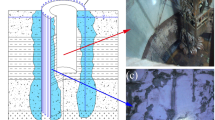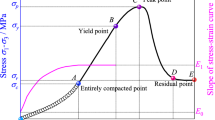Abstract
The artificial ground freezing (AGF) method has been widely used in underground engineering construction. As the main load-bearing elements of the AGF method, the strength of frozen walls is expected to play a crucial role in engineering stability. To improve the accuracy of quantitative evaluations of engineering stability, it is necessary to grasp the strength characteristics of frozen rock during service. To achieve this, the red sandstone taken from a frozen shaft project was tested via triaxial compression at different temperatures (−5°C,−10°C,−15°C,−20°C,−25°C, and −30°C). After that, a damage constitutive model with a Weibull distribution was derived to characterize the damage development of the frozen sandstone. Based on the validated model, the variation of damage degree was analyzed. The results show that the crack initiation stress, crack dilation stress, and peak strength all increase with decreasing temperature. The crack damage threshold increases as the frozen sandstone strength increases. The presented damage constitutive model can reflect the damage evolution of frozen sandstone. When the stress exceeds the crack initiation stress, the damage degree begins to increase, and it increases quickly when the stress approaches the peak strength. The model parameters can reflect the influence of negative temperatures on the strength of frozen sandstone. The crack damage threshold could be treated as an essential intrinsic property for predicting the failure process of frozen sandstones. The results can provide an important reference for the design and construction of frozen ground engineering.












Similar content being viewed by others

Availability of data and materials
The datasets generated during and/or analyzed during the current study are available from the corresponding author on reasonable request.
References
Bayram F (2012) Predicting mechanical strength loss of natural stones after freeze-thaw in cold regions. Cold Reg Sci Technol 83:98–102. https://doi.org/10.1016/j.coldregions.2012.07.003
Cai M, Kaiser PK, Tasakab Y, Maejimac T, Moriokac H, Minamic M (2004) Generalized crack initiation and crack damage stress thresholds of brittle rock masses near underground excavations. Int J Rock Mech Min Sci 41:833–847. https://doi.org/10.1016/j.ijrmms.2004.02.001
Cerfontaine B, Charlier R, Conllin F, Taiebat M (2017) Validation of a new elastoplastic constitutive model dedicated to the cyclic behaviour of brittle rock materials. Rock Mech Rock Eng 50:2677–2694. https://doi.org/10.1007/s00603-017-1258-3
Jones JS, Brown RE (1979) Design of tunnel support systems using ground freezing. Eng Geol 13:375–395. https://doi.org/10.1016/0013-7952(79)90044-9
Diederichs MS (2003) Manuel rocha medal recipient rock fracture and collapse under low confinement conditions. Rock Mech Rock Eng 36:339–381. https://doi.org/10.1007/s00603-003-0015-y
Diederichs MS, Kaiser PK, Eberhardt E (2004) Damage initiation and propagation in hard rock during tunnelling and the influence of near-face stress rotation. Int J Rock Mech Min Sci 41:785–812. https://doi.org/10.1016/j.ijrmms.2004.02.003
Deng J, Gu DS (2011) On a statistical damage constitutive model for rock materials. Comput Geosci 37:122–128. https://doi.org/10.1016/j.cageo.2010.05.018
Dougill JW, Lau JC, Burtn J (1976) Toward a theoretical model for progressive failure and softening in rock concrete and similar materials. Mech Eng 102:333–355
Duca S, Alonso EE, Scavia C (2015) A permafrost test on intact gneiss rock. Int J Rock Mech Min Sci 77:142–151. https://doi.org/10.1016/j.ijrmms.2015.02.003
Gautam PK, Verma AK, Maheshwar S, Singh TN (2016) Thermomechanical analysis of different types of sandstone at elevated temperature. Rock Mech Rock Eng 49(5):1985–1993. https://doi.org/10.1007/s00603-015-0797-8
Huang S, Liu QS, Cheng AP, Liu YZ (2018) A statistical damage constitutive model under freeze-thaw and loading for rock and its engineering application. Cold Reg Sci Technol 145:142–150. https://doi.org/10.1016/j.coldregions.2017.10.015
Jiang Y, Zhuang Q, O’Donnell JA (2012) Modeling thermal dynamics of active layer soils and near-surface permafrost using a fully coupled water and heat transport model. J Geophys Res 117:D11110. https://doi.org/10.1029/2012JD017512
Kodama J, Goto T, Fujii Y, Hagan P (2013) The effects of water content temperature and loading rate on strength and failure process of frozen rocks. Int J Rock Mech Min Sci 62:1–13. https://doi.org/10.1016/j.ijrmms.2013.03.006
Krajcinovic D, Silva MAG (1982) Statistical aspects of the continuous damage theory. Int J Solids Struct 18:551–562. https://doi.org/10.1016/0020-7683(82)90039-7
Lemaitre J (1985) A continuous damage mechanics model for ductile fracture. J Eng Mater Technol 107:83–89. https://doi.org/10.1115/1.3225775
Li CB, Xie HP, Wang J (2020) Anisotropic characteristics of crack initiation and crack damage thresholds for shale. Int J Rock Mech Min Sci 126:104178. https://doi.org/10.1016/j.ijrmms.2019.104178
Li X, Cao WG, Su YH (2012) A statistical damage constitutive model for softening behavior of rocks. Eng Geol 143:1–17. https://doi.org/10.1016/j.enggeo.2012.05.005
Lin Y, Zhou KP, Gao F, Li JL (2019) Damage evolution behavior and constitutive model of sandstone subjected to chemical corrosion. Bull Eng Geol Environ 78:5991–6002. https://doi.org/10.1007/s10064-019-01500-7
Liu Y, Dai F (2018) A damage constitutive model for intermittent jointed rocks under cyclic uniaxial compression. Int J Rock Mech Min Sci 103:289–301. https://doi.org/10.1016/j.ijrmms.2018.01.046
Liu B, Ma YJ, Sheng HL, Deng HL, Han Q, Cao YJ (2019) Experimental study on mechanical properties of Cretaceous red sandstone under different freezing temperatures and confining pressures. Chin J Rock Mech Eng 38:455–466. https://doi.org/10.13722/j.cnki.jrme.2018.0780
Ma W, Zhou GQ, Niu FJ, Mu YH (2017) Progress and prospect of the basic research on the major permafrost projects in the Qinghai-Tibet Plateau. Chin Basic Sci 6:9–22
Martin CD, Chandler NA (1994) The progressive fracture of Lac du Bonnet granite. Int J Rock Mech Min Sci Geomech Abstr 31:643–659. https://doi.org/10.1016/0148-9062(94)90005-1
Qu DX, Li DK, Li XP, Luo Y, Xu K (2018) Damage evolution mechanism and constitutive model of freeze-thaw yellow sandstone in acidic environment. Cold Reg Sci Technol 155:174–183. https://doi.org/10.1016/j.coldregions.2018.07.012
Russo G, Corbo A, Cavuoto F, Autuori S (2015) Artificial ground freezing to excavate a tunnel in sandy soil measurements and back analysis. Tunn Undergr Space Technol 50:226–238. https://doi.org/10.1016/j.tust.2015.07.008
Wang Z, Li Y, Wang JG (2007) A damage-softening statistical constitutive model considering rock residual strength. Comput Geosci 33:1–9. https://doi.org/10.1016/j.cageo.2006.02.011
Wagner AM (2013) Creation of an artificial frozen barrier using hybrid thermosyphons. Cold Reg Sci Technol 96:108–116. https://doi.org/10.1016/j.coldregions.2013.08.008
Weibull WA (1951) A statistical distribution function of wide applicability. J Appl Mech 18:293–297
Xi DY, Xu SL (2016) Rock physics and constitutive theory. Press of University of Science and Technology of China, Hefei
Xie SJ, Lin H, Chen YF, Yong R, Xiong W, Du SG (2020) A damage constitutive model for shear behavior of joints based on determination of the yield point. Int J Rock Mech Min Sci 128:104269. https://doi.org/10.1016/j.ijrmms.2020.104269
Xu XL, Karakus M, Gao F, Zhang ZZ (2018) Thermal damage constitutive model for rock considering damage threshold and residual strength. J Cent South Univ 25:2523–2536. https://doi.org/10.1007/s11771-018-3933-2
Xu WY, Wei LD (2002) Study on statistical damage constitutive model of rock. Chin J Rock Mech Eng 21:787–791
Xue L, Qin SQ, Sun Q, Wang YY, Lee ML, Li WC (2014) A study on crack damage stress thresholds of different rock types based on uniaxial compression tests. Rock Mech Rock Eng 47:1183–1195. https://doi.org/10.1007/s00603-013-0479-3
Yamabe T, Neaupanek KM (2001) Determination of some thermo-mechanical properties of Sirahama sandstone under subzero temperature conditions. Int J Rock Mech Min Sci 38:1029–1034. https://doi.org/10.1016/s1365-1609(01)00067-3
Yang GS, Jv YL, Xi JM (2014) Study of mechanical properties and temperature field of frozen wall in Cretaceous strata. Chin J Rock Mech Eng 43:1873–1879
Yang GS, Wei Y, Shen YJ, Wang L, Liu H, Dong XH, Li XJ (2019) Mechanical behavior and strength forecast model of frozen saturated sandstone under triaxial compression. Chin J Rock Mech Eng 38:683–694. https://doi.org/10.13722/j.cnki.jrme.2018.1417
Zhou SW, Xia CC, Zhao HB, Mei SH, Zhou Y (2017) Statistical damage constitutive model for rocks subjected to cyclic stress and cyclic temperature. Acta Geophys 65:893–906. https://doi.org/10.1007/s11600-017-0073-2
Acknowledgements
The authors would like to thank the coal mine for providing the red sandstone samples.
Funding
(1) The Second Tibetan Plateau Scientific Expedition and Research (STEP) program (No. 2019QZKK0905); (2) the Key Research Program of the Chinese Academy of Sciences (No. ZDRW-ZS-2020–1); (3) the Youth Innovation Promotion Association CAS (Feng Ming).
Author information
Authors and Affiliations
Contributions
Feng Ming: conceptualization, investigation, funding acquisition, formal analysis, data curation, writing—original draft preparation. Shujuan Zhang: resources, methodology, investigation, writing—original draft preparation. Fujun Niu: supervision, methodology, funding acquisition, writing—reviewing and editing. Zhiwei Zhou: writing—reviewing and editing.
Corresponding authors
Ethics declarations
Conflict of interest
The authors declare no competing interests.
Rights and permissions
About this article
Cite this article
Ming, F., Zhang, S., Niu, F. et al. A study on crack damage stress and the damage constitutive model of frozen sandstone. Bull Eng Geol Environ 80, 6955–6970 (2021). https://doi.org/10.1007/s10064-021-02361-9
Received:
Accepted:
Published:
Issue Date:
DOI: https://doi.org/10.1007/s10064-021-02361-9



